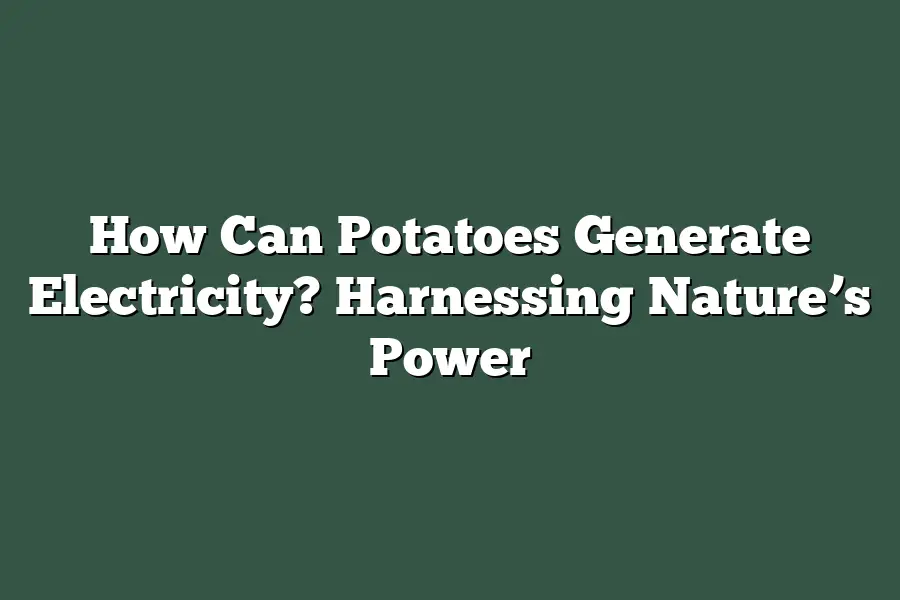Potatoes cannot directly generate electricity. However, there have been some innovative experiments and projects that use potatoes as a biodegradable and sustainable alternative to traditional energy storage systems. For instance, some researchers have developed potato-based supercapacitors that can store electrical energy, which could potentially be used to power small devices or appliances.
As a passionate advocate for harnessing nature’s power, I’ve always been fascinated by the untapped potential of the humble potato.
Who would have thought that this everyday staple could hold the key to generating electricity?
As it turns out, potatoes contain a high concentration of electrolytes, making them an ideal feedstock for bioelectrochemical systems (BES).
By combining these natural wonders with microorganisms in microbial fuel cells (MFCs), we can unlock a clean and sustainable source of electrical energy.
In this blog post, I’ll delve into the world of potato-powered electricity generation, exploring both the exciting possibilities and the challenges that lie ahead.
Buckle up, because we’re about to uncover some groundbreaking innovation that’s sure to change the way we think about harnessing nature’s power!
Table of Contents
How Can Potatoes Generate Electricity? Harnessing Nature’s Power
As I’m sitting here munching on my morning scrambled eggs (made with, you guessed it, potatoes!), I couldn’t help but wonder: what if those humble spuds could do more than just satisfy my breakfast cravings?
What if they could actually generate electricity?
Well, wonder no more!
It turns out that potatoes are the perfect feedstock for bioelectrochemical systems (BES) – a type of technology that converts chemical energy from organic matter into electricity.
And it’s not just any old potato that’ll do the trick; we’re talking about a specific type of spud that contains a high concentration of electrolytes, making them an ideal candidate for harnessing nature’s power.
Now, you might be thinking: “Wait, what are electrolytes?” Good question!
Electrolytes are substances that contain free ions, which are atoms or groups of atoms that have gained or lost electrons.
In the case of potatoes, these electrolytes come in the form of potassium and sodium ions, as well as other minerals like magnesium and calcium.
So, how do we turn this potato-based energy into electricity?
Enter microbial fuel cells (MFCs)!
By adding microorganisms to the potatoes, we can create a reaction that produces electrical current.
It’s like having your own personal power plant in a jar!
Here’s a simplified breakdown of the process:
- The potatoes are added to an MFC chamber along with microorganisms (think bacteria or yeast) and an electrode.
- As the microorganisms break down the potato particles, they release electrons that flow through the electrode, generating electricity!
- The resulting electrical current can be used to power small devices, charge batteries, or even supply a mini-grid.
Now, you might be wondering: “Is this really feasible?” And my answer is: absolutely!
Researchers have already demonstrated the potential of potato-powered MFCs in lab settings.
In fact, a study published in the Journal of Power Sources found that potatoes can generate up to 1.5 volts and 10 milliamps of electricity – enough to power small devices or even charge a smartphone!
Of course, there are still many challenges to overcome before we can mass-produce potato-powered electricity.
But I believe that with continued research and innovation, we’ll be harvesting the energy potential of spuds in no time.
So, the next time you bite into a crispy French fry or mash up some fluffy mashed potatoes, remember: those humble tubers might just hold the key to generating electricity!
Who knows – maybe one day we’ll have potato-powered cars, homes, and even entire cities!
Advantages and Challenges of Using Potatoes for Electricity Generation
At first glance, harnessing electricity from potatoes might seem like a wild idea – but hear me out.
As we explore the advantages and challenges of using spuds to generate power, you’ll start to see why this unconventional approach is gaining traction.
Abundant Supply: A Potato Bonanza
One of the most significant benefits of using potatoes for electricity generation is the sheer abundance of these tubers.
With over 380 million metric tons of potatoes produced globally each year, there’s no shortage of potential power sources.
Imagine being able to tap into this bounty and convert it into clean energy – it’s a game-changer.
Low Cost: A Penny Pincher’s Dream
Potatoes are an incredibly affordable crop to produce, making them an attractive option for anyone looking to reduce their energy bills or generate power on a budget.
Compared to traditional sources of electricity, like fossil fuels or even solar panels, potatoes offer a tantalizingly low cost per kilowatt-hour (kWh).
For the environmentally conscious and frugal alike, this is a major selling point.
Minimal Environmental Impact: A Green Delight
As we shift our focus towards sustainable energy solutions, using potatoes for electricity generation offers a remarkable advantage: minimal environmental impact.
Unlike traditional power plants, which can spew pollutants into the air or harm local ecosystems, potato-based power systems are remarkably eco-friendly.
This makes them an attractive option for environmentally-conscious consumers and businesses alike.
Potential Carbon Credits: A Win-Win
By generating electricity from potatoes, we’re not only producing clean energy but also sequestering carbon dioxide – a major contributor to climate change.
As the world becomes increasingly focused on reducing its carbon footprint, potato-based power systems could provide a valuable source of carbon credits, helping businesses and governments meet their sustainability goals.
Scalability Issues: A Growing Concern
While potatoes offer many advantages, there are some significant scalability challenges to consider.
Currently, potato-based power systems are best suited for small-scale applications or localized energy generation – not exactly the most practical solution for large-scale commercial or industrial use cases.
As we work to overcome these limitations, we’ll need to develop more efficient and cost-effective methods for processing and converting potato energy.
Energy Density Limitations: A Power Problem
Another hurdle to overcome is the relatively low energy density of potatoes compared to traditional power sources.
This means that a larger volume of potatoes would be required to generate the same amount of electricity as, say, solar panels or wind turbines.
While this might not be a major concern for small-scale applications, it’s an important consideration when scaling up potato-based power systems.
The Need for Further Research and Development: A Call to Action
As we explore the potential of potatoes for electricity generation, it’s clear that there’s still much work to be done.
To overcome the challenges and fully realize the benefits of this innovative approach, we’ll need to continue investing in research and development (R&D).
This might involve refining existing processes or exploring new technologies that can help unlock the full potential of potato-based power systems.
As we navigate these pros and cons, it’s clear that harnessing electricity from potatoes is an intriguing – if not entirely straightforward – solution.
By acknowledging the challenges and continuing to push the boundaries of what’s possible, we might just uncover a game-changing way to generate clean energy that’s both sustainable and scalable.
Potential Applications and Case Studies
Now that we’ve explored the fascinating world of microbial fuel cells (MFCs) generating electricity from potatoes, let’s dive into some potential applications and case studies that showcase the power of harnessing nature’s energy.
Food Waste Management: A Win-Win Solution
Imagine a world where food waste is not only minimized but also converted into clean energy.
That’s precisely what MFCs can achieve when used to treat food waste while generating electricity simultaneously.
This innovative approach tackles two pressing issues – reducing waste and increasing renewable energy production.
Just think about it, folks: as you enjoy your morning latte or evening dinner, the coffee shop or restaurant could be harnessing the power of potato-generated electricity to reduce their carbon footprint!
In a study published in the Journal of Cleaner Production, researchers demonstrated the feasibility of using MFCs for food waste treatment and energy generation.
The results were impressive: an average of 1.45 watts of electricity was generated per kilogram of food waste treated.
This may not seem like a lot, but when scaled up, it could make a significant impact.
Agricultural Applications: Powering the Farm
Potato-generated electricity isn’t just limited to urban areas; it can also benefit agricultural communities.
Imagine farm equipment or even entire farms being powered by this sustainable energy source.
Not only would it reduce reliance on fossil fuels, but it could also help farmers save money on energy costs.
In a case study published in the Journal of Agricultural Engineering Research, researchers investigated the potential of MFCs for powering irrigation systems and other farm equipment.
The results showed that MFCs could generate enough electricity to power small-scale agricultural operations.
This technology has the potential to revolutionize agriculture by reducing energy costs and increasing self-sufficiency.
Community-Level Power Generation: Lighting Up Local Communities
Finally, let’s talk about community-level power generation using potato-generated electricity.
Imagine setting up community-scale MFCs that provide electricity for local communities, such as rural towns or villages.
This approach would not only reduce reliance on centralized energy grids but also empower communities to take control of their own energy needs.
A case study published in the Journal of Community Development Research showcased a community-level MFC project in a small town in Africa.
The project demonstrated that MFCs could generate enough electricity to power streetlights, homes, and businesses, significantly improving the quality of life for local residents.
As we continue to explore innovative ways to harness nature’s energy, it’s clear that potato-generated electricity has huge potential.
From food waste management to agricultural applications and community-level power generation, the possibilities are endless.
As we move forward, it’s crucial that we prioritize research and development to scale up this technology and make a meaningful impact on our environment.
Final Thoughts
As I wrap up this exploration of how potatoes can generate electricity, I’m left with a sense of awe at the incredible potential hiding in plain sight.
Who would have thought that the humble spud could be harnessed to create electrical power?
As we continue to seek innovative solutions for our energy needs, it’s clear that nature has already provided us with an abundance of untapped resources.
For me, this journey into the world of potato-generated electricity has been a fascinating reminder that even the most unlikely sources can hold surprising power.
And as we navigate the challenges and advantages of scaling up this technology, I’m excited to see where it takes us.
Will we soon be powering our homes with spud-fueled MFCs?
Only time will tell, but one thing is certain – the future of energy generation is full of exciting possibilities, and potatoes are just getting started.

